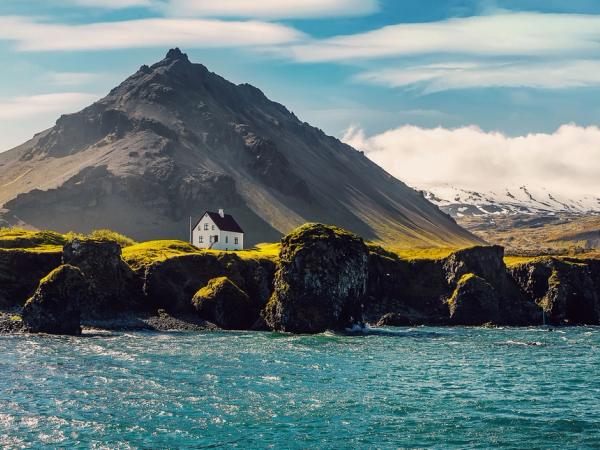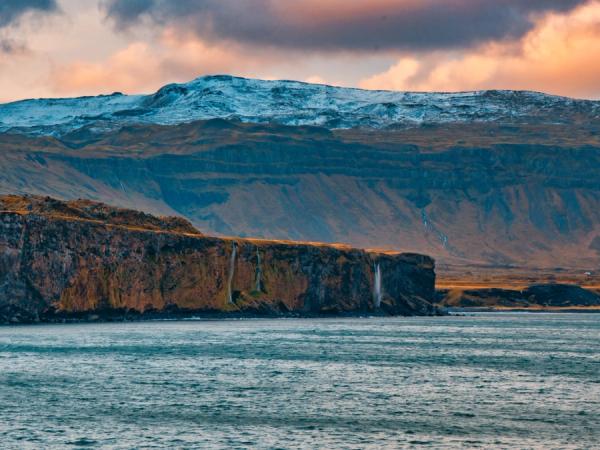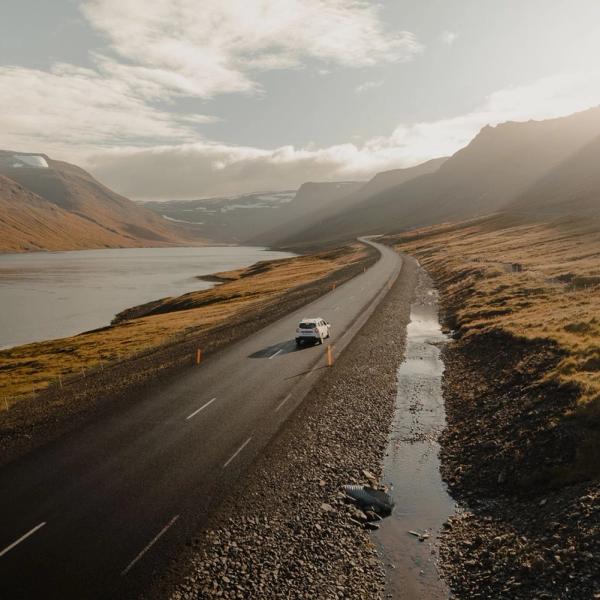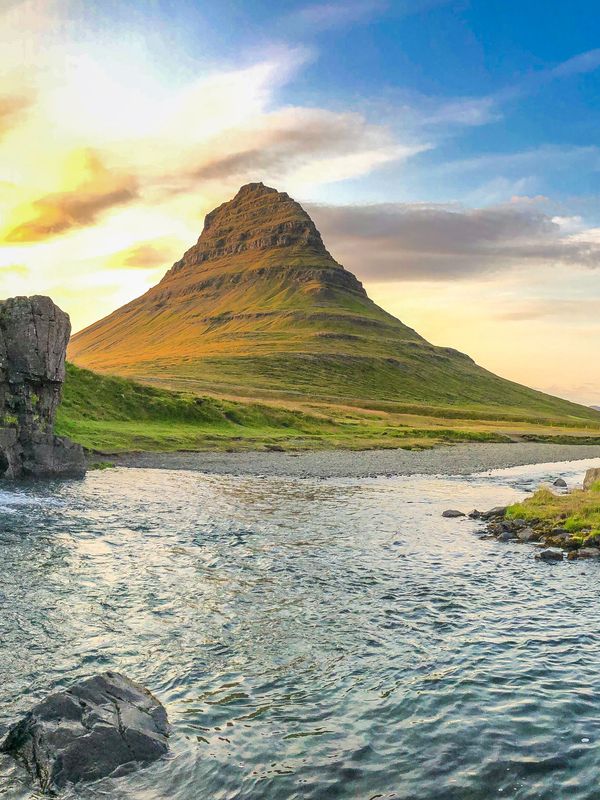
Arnarstapi, One of The Most Charming Towns in Iceland
If there’s something that sets Iceland apart from other places in the world, that’s its impressive collection of natural monuments. Absolute wonders that have been formed by the forces of the Earth and sculpted throughout thousands of years. However, this country is not just that. It also has a strong and vibrant cultural life, and a collection of cities and towns worth a visit. And some of those places manage to bring together those two worlds, the natural and the man-made.
Welcome to Arnarstapi, a hidden gem in West Iceland. This small but charming fishing village is located in the Snæfellsnes Peninsula and is a must-stop town if you go to this part of the country. Despite its small size, Arnarstapi is packed with history, culture, and incredible landscapes. It has a bit of everything: from ancient folklore to fascinating rock formations, this village offers travelers a unique look into Iceland’s natural and cultural heritage. Come with us to discover this amazing corner of Iceland.
Key Takeaways
- Arnarstapi is a small fishing town located on the south coast of the Snæfellsnes Peninsula, in West Iceland.
- It’s inside Snæfellsjökull National Park, one of the three national parks there are in Iceland.
- The coastal path that links Arnarstapi with Hellnar is one of the best easy hikes in the country.
Where’s Arnarstapi and How to Get There?
Arnarstapi is located on the southern coast of the Snæfellsnes Peninsula in western Iceland. This relatively small area is a microcosm of Iceland's diverse landscape, showcasing volcanic mountains, black sand beaches, lava fields, glaciers, and dramatic cliffs.
This region is known for being the home of Snæfellsjökull National Park, one of the three national parks in Iceland. It gets its name from the Snæfellsjökull glacier, an ice-capped volcano that crowns the region and is both a geological wonder and a place of literary fame. But we’ll talk about it later.
Arnarstapi is about 188 kilometers (117 miles) from Reykjavik, Iceland’s capital. The best way to get there and to move around Iceland in general is by renting a car. The journey from Reykjavik takes roughly 2.5 hours. Take Route 1, also known as the Ring Road, Iceland’s most important road, and head north. After about an hour and a half, just after passing through the city of Borgarnes, take Route 54, which goes to the Snæfellsnes Peninsula. After 100 kilometers, you’ll see a sign announcing the exit for Arnarstapi (Route 574).
History of Arnarstapi
Arnarstapi may be a small village, but it also shows the strong connection between Iceland and the ocean. The village’s name is often shortened to just Stapi by the locals. Historically, Arnarstapi was an important fishing port and trading post, serving as a key hub for the surrounding region during Iceland’s Viking Age and medieval period. It’s located on a natural harbor, which is uncommon in the country.
Back in the day, fishing was one of Iceland’s most vital industries, and villages like Arnarstapi were essential for providing fish to both local and foreign markets. The remains of stone docks and old houses from this time can still be seen along the coastline.
Arnarstapi is also steeped in mythology. The village features in Bárðar saga Snæfellsáss, one of the sagas of the Icelanders. According to legend, Bárður Snæfellsás was a half-man, half-troll who became the guardian spirit of the Snaefellsnes Peninsula. He is said to live in the glacier-covered volcano Snæfellsjökull, which is a constant presence in the area. The saga tells of Bárður's strength, wisdom, and mystical powers, which he used to protect the region’s people. There’s a big stone statue of Bárður in Arnarstapi.
What to See and Do Near Arnarstapi
Though Arnarstapi is a quiet village, there are many things to see and do in the surrounding area.
Gatklettur Arch Rock
This natural wonder is in Arnarstapi, probably its most iconic sight. Gatklettur is a stunning natural arch that has been carved out of the basalt cliffs by the relentless forces of the Atlantic Ocean. This photogenic formation stands as a testament to the power of nature, and it’s a popular spot for photographers. This spot is a must-see for anyone visiting Arnarstapi, and it’s just a short walk from the village center.
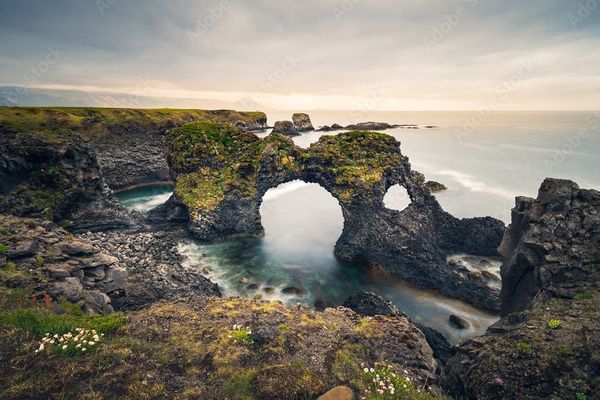
Snæfellsjökull National Park
As we said before, Arnarstapi is inside Snæfellsjökull National Park, which is home to the famous Snæfellsjökull glacier and volcano. This national park, the only one that includes marine and terrestrial areas, has a wide variety of hiking trails, lava fields, caves, and volcanic craters. Snæfellsjökull itself is a stratovolcano topped by a glacier, and it’s where Jules Verne placed the entrance to a fantastical underground world in the classic novel Journey to the Center of the Earth, where it served as the entrance.
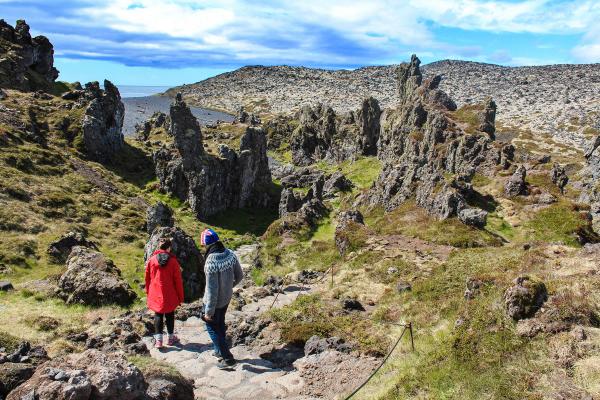
The coastal walk from Arnarstapi to Hellnar
One of the most popular activities in the area is the coastal hike from Arnarstapi to Hellnar, a neighboring village. This 2.5-kilometer (1.5-mile) trail takes you along the coast and is suitable for most fitness levels. Along the way, you can see several bird species nesting on the cliffs, including puffins in the summer months. The views are breathtaking, with the endless expanse of the ocean on one side and dramatic lava formations on the other. Hellnar itself is a charming village with a cozy café where you can take a break after the hike.
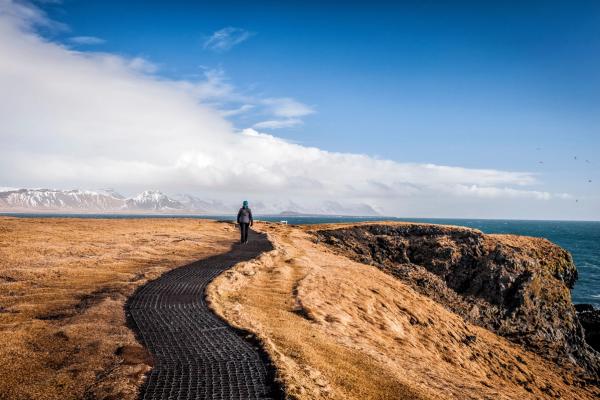
Sönghellir Cave
Sönghellir, also known as the "Cave of Song," is a fascinating lava cave near Arnarstapi. This cave is famous for its remarkable acoustics, which amplify sounds and voices. In the past, Sönghellir was often used as a shelter by travelers, and its walls are covered with ancient carvings and inscriptions. Visitors today can still experience the cave’s unique echoing effect.
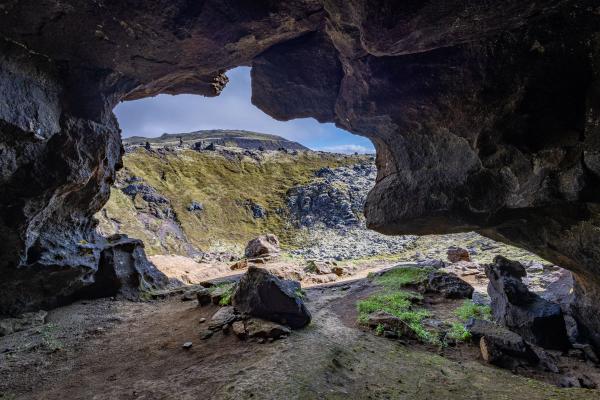
Whale Watching
Whale watching is a popular activity many tourists look for when coming to Iceland. The waters around the Snaefellsnes Peninsula are home to a variety of whale species, including orcas, minkewhales, and humpback whales. The town of Olafsvík, on the north shore of the peninsula, has many boat tours operating.
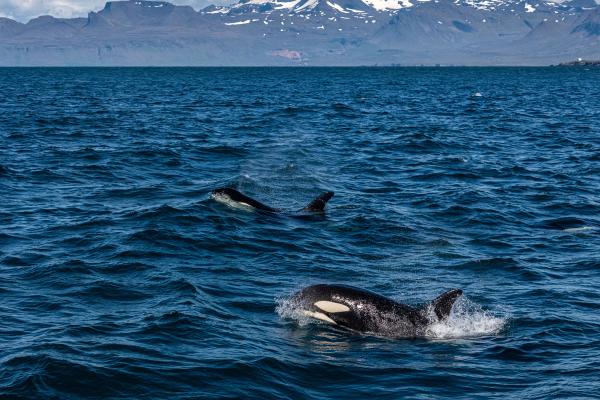
Lóndrangar Cliffs
Another natural wonder near Arnarstapi is the Lóndrangar cliffs, a pair of towering basalt columns that rise dramatically from the ocean. These ancient volcanic columns were once part of a larger crater that has been eroded by elements with the passing of the centuries. Local folklore tells the story that these formations are two trolls turned into stone by the sun. Lóndrangar is not only a breathtaking sight but also an important nesting area for seabirds, including fulmars and kittiwakes. The cliffs are easily accessible by car and are a great stop for photographers and bird watchers alike.
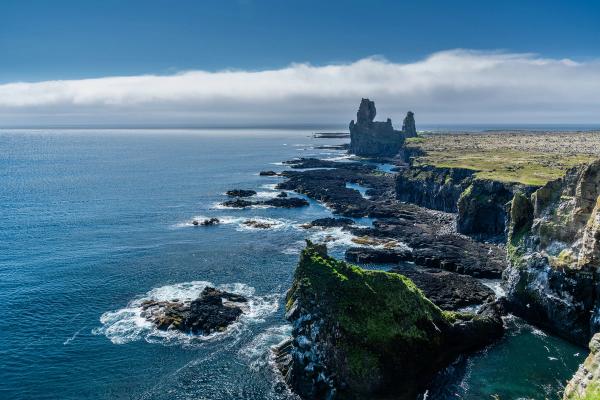
Vatnshellir Cave
For the more adventurous, exploring Vatnshellir Cave is an experience like no other. Located within Snæfellsjökull National Park, this 8,000-year-old lava tube descends 35 meters below the surface. Guided tours take you deep into the earth, where you can see the fascinating colors and textures left behind by ancient volcanic activity. The visit to the cave must be done with an experienced guide and proper equipment.

The Weather in Arnarstapi
Understanding the weather is essential when planning a trip to Arnarstapi. Well, to Iceland in general. The weather here is unpredictable and changes constantly and quickly, so it’s essential to be prepared for different situations.
Summer (June to August)
Summer is the most popular time to visit Arnarstapi, as temperatures are relatively mild, averaging between 10°C and 15°C (50°F to 59°F). The daylight hours are really long, with almost 24 hours of light by the end of June, which provides plenty of time for exploration. It’s also the best time to see puffins. The best way to adapt to the weather here is to wear layers, even in summer, and don’t forget a waterproof jacket.
Autumn (September and October)
This season comes with cooler temperatures and decreased daylight hours, which get shorter by the week. The average temperature during this season ranges from 5°C to 10°C (41°F to 50°F). The vibrant colors of autumn come into play and transform the landscapes with its palette of colors. While the days grow shorter, autumn is a great time to visit if you want to avoid the summer crowds. Just be prepared for more frequent rain and stronger winds.
Winter (November to March)
Winter has its own pros and cons in Iceland. The atmosphere becomes magical, with the snow-covered landscapes and higher chances to see the Northern Lights. Temperatures in winter range from -5°C to 5°C (23°F to 41°F), but the coastal location means that Arnarstapi is often milder than other parts of Iceland. However, storms and high winds are more frequent, and daylight is limited to just a few hours each day.
Spring (April and May)
Spring in Arnarstapi is a time of renewal, as the snow begins to melt and the landscape bursts into life. Average temperatures during spring go between 0°C and 10°C (32°F to 50°F). This is a shoulder season, so you’ll find fewer tourists and quieter hiking trails. Spring weather can still be unpredictable, with sudden rain or snow showers. However, on a clear day, the views of the surrounding mountains and sea are spectacular.
Travel Tips
- Pack for all weather: As we have explained before, dressing in layers can make a difference in your trip. This way, you can add or remove items to adjust to the sudden changes. Don’t forget to bring waterproof clothing.
- Bring a camera: The landscape around Arnarstapi is breathtaking, and you’ll want to capture its beauty. There are endless photo opportunities in the area.
- Check the weather forecast and the road conditions: The Icelandic Met Office provides live forecasts, which are pretty accurate. The weather can affect the roads, and, normally, many are closed due to the weather, especially in winter, late autumn and early spring. Check the status before setting off.
- ·Book in advance: While Arnarstapi has a few options for staying overnight, including guesthouses and cottages, they can fill up quickly during the summer months. If you’re planning to stay the night, booking in advance is a smart move. This also applies to some of the activities you can do in the area.
- Fuel up: There usually are gas stations in major cities and towns, but some rural areas don’t see a station for many miles. Fill up your tank whenever you have the chance.
- ·Respect nature: Iceland’s landscapes are fragile, so always stick to marked paths, avoid stepping on moss or vegetation, and take any trash you generate with you.
Conclusion
Arnarstapi is a tiny village with a big personality, offering a slice of Iceland’s rugged beauty, rich history, and mystical folklore. Even if it’s small, it’s beautiful and charming, with beautiful surroundings that are waiting for you to explore.
It’s located in a region that encapsulates some of the best Iceland has to offer. Here, you'll find a bit of everything, and we are sure that you’ll love this part of Iceland.

